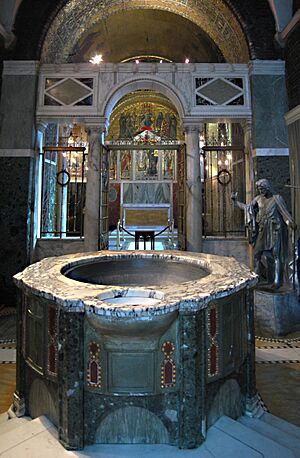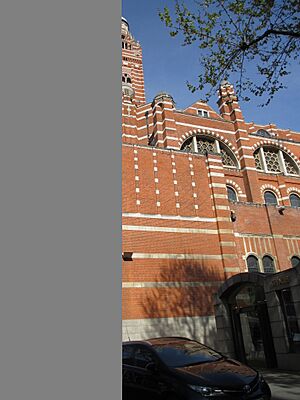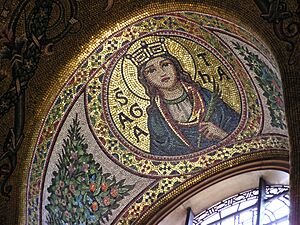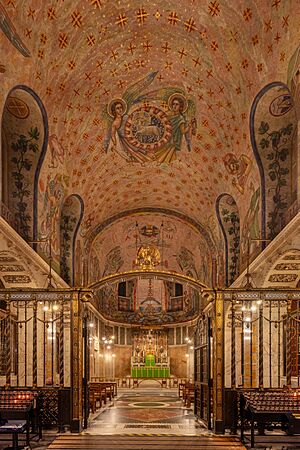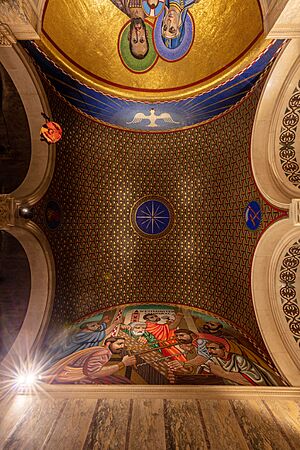Westminster Cathedral facts for kids
Quick facts for kids Metropolitan Cathedral of theMost Precious Blood Westminster Cathedral |
|
|---|---|
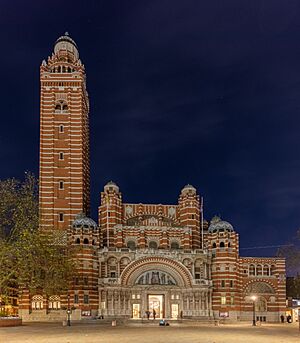
Frontal view as seen from Victoria Street
|
|
| Lua error in Module:Location_map at line 420: attempt to index field 'wikibase' (a nil value). | |
| OS grid reference | TQ 29248 79074 |
| Location | Francis Street, Westminster London, SW1 |
| Country | England |
| Denomination | Roman Catholic |
| History | |
| Status | Cathedral |
| Dedication | Most Precious Blood |
| Consecrated | 1910 |
| Architecture | |
| Architect(s) | John Francis Bentley |
| Style | Neo-Byzantine |
| Years built | 1895–1903 |
| Specifications | |
| Length | 110m (360ft) |
| Width | 47m (156ft) |
| Number of towers | 1 |
| Tower height | 87m (284ft), including the cross |
| Administration | |
| Diocese | Westminster (since 1884) |
| Province | Westminster |
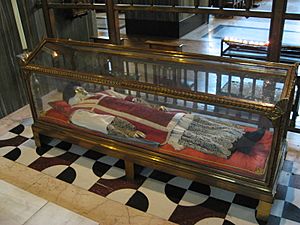
Westminster Cathedral, also known as the Metropolitan Cathedral of the Most Precious Blood, is the largest Roman Catholic church in England and Wales. It is dedicated to the Blood of Jesus Christ and is the main church for the Archbishop of Westminster.
The land for the cathedral was bought in 1885 in the City of Westminster. Construction finished in 1903. The architect, John Francis Bentley, designed it in a neo-Byzantine style, similar to churches from the 9th century. It is built mostly of brick without steel supports. Sir John Betjeman called it "a masterpiece in striped brick and stone."
Important visitors have included Pope John Paul II in 1982 and Pope Benedict XVI in 2010.
Contents
History of the Cathedral
In the late 1800s, the Roman Catholic Church was becoming strong again in England. People wanted to build a new cathedral to remember Cardinal Wiseman, who was the first Archbishop of Westminster.
The land for the cathedral was bought in 1884 by Cardinal Manning. Before that, a prison called Tothill Fields Bridewell was on the site. Building work started in 1895 under Cardinal Vaughan, with John Francis Bentley as the architect. The design was greatly inspired by Byzantine architecture.
The foundation stone was blessed on June 29, 1895, in a special ceremony. The cathedral officially opened in 1903, a year after Bentley passed away. One of the first services held there was Cardinal Vaughan's funeral, as he died shortly after it opened.
A church can only be officially consecrated (made sacred) if it has no debt. So, the consecration ceremony for Westminster Cathedral took place on June 28, 1910, after all the building costs were paid off.
The inside of the cathedral was not fully decorated at the time of its consecration. This is because in Byzantine churches, decorations like mosaics are added later. So, finishing the beautiful marble and mosaic decorations was left for future generations.
In 1895, the cathedral was dedicated to the Most Precious Blood of Our Lord Jesus Christ. This is remembered by a Latin message above the main entrance:
Latin: Domine Jesus Rex et Redemptor per Sanguinem tuum salva nos
(English: "Lord Jesus, King and Redeemer, save us through your blood").
The cathedral also honors other saints, including the Blessed Virgin Mary, Saint Joseph, Saint Peter, Saint Augustine, and Saint Patrick.
Over the years, the cathedral has hosted many important events:
- In 1977, Queen Elizabeth II visited the cathedral for a flower show during her Silver Jubilee.
- On May 28, 1982, Pope John Paul II celebrated Holy Mass here during his visit to the UK.
- On November 30, 1995, Queen Elizabeth II returned to attend a special evening service, which was the first time she had attended a Roman Catholic service in Great Britain.
- On September 18, 2010, Pope Benedict XVI celebrated Mass in the cathedral during his visit to the UK.
- In January 2011, the cathedral held a special ceremony for former Anglican bishops joining the Catholic Church.
- In 2012, the cathedral was featured in a BBC Four documentary series called Catholics.
- In May 2021, during the Covid Pandemic, Prime Minister Boris Johnson and Carrie Symonds were married at the Cathedral.
Cathedral Design and Features
Westminster Cathedral is one of the largest churches in the world. It can seat up to 2,000 people.
The entire building is designed in the neo-Byzantine style. The main part of the church, called the nave, is 18 meters (59 feet) wide and 70 meters (230 feet) long. It has large domed ceilings.
The main parts of the building are made of brick and concrete. The outside has white stone bands mixed with red brick, which gives it a unique look. The bricks were made by hand. The main entrance has a deep arch with towers on either side.
Inside, marble columns with special Byzantine-style tops support the galleries. Some of the marble used for these columns came from ancient Roman quarries in Greece.
High Altar
The most important decoration inside the cathedral is the baldacchino over the high altar. This is a very large canopy, about 9.5 meters (31 feet) wide and 11.5 meters (38 feet) high. It is made of white marble with colorful marble, lapis lazuli, pearl, and gold decorations. Eight yellow marble columns from Verona support it.
Below the high altar is a crypt, which is an underground room. Here, the remains of the first two Archbishops of Westminster, Cardinal Wiseman and Cardinal Manning, are buried. A large Byzantine-style crucifix hangs above the main hall, making a strong impression.
Chapels
The cathedral has many beautiful chapels. The Chapel of the Blessed Sacrament and the Lady Chapel are on either side of the main altar area. They are wide and tall, with arched ceilings. The Blessed Sacrament chapel has a small canopy over its altar and is enclosed by bronze gates. The Lady Chapel has marble walls and a mosaic of the Virgin and Child above its altar.
Other chapels can be found along the sides of the main hall. Each chapel has its own unique artistic style. For example, the chapel of Saints Gregory and Augustine has bright mosaics. In contrast, the chapel of the Holy Souls has a more quiet, solemn decoration with silver backgrounds.
Along the outer aisles, you can find the Stations of the Cross. These are sculptures by Eric Gill and are considered some of his best work.
Mosaics and Art
When the architect John Bentley died, there were no finished mosaics in the cathedral. He left very few drawings for them. This meant that the designs for the mosaics were often chosen by the people who donated money for them, or by a special committee.
Many of the early mosaics, installed between 1912 and 1916, were made by artists from the Arts and Crafts Movement. The mosaics in the Lady Chapel were done by Gertrude Martin. The large mosaic of Christ enthroned above the main entrance was designed later. This mosaic shows Saint Peter, the Virgin Mary, Jesus Christ, Saint Joseph, and Edward the Confessor. Jesus holds a book that says in Latin: Ego sum ostium per me si quis introierit salvabitur (I am the gate; whoever enters through me will be saved).
A lot of mosaic work was done between 1930 and 1935, including in the Lady Chapel and the crypt.
New mosaics continued to be added over the years. In the 1960s, the Blessed Sacrament Chapel was decorated with mosaics in a traditional Christian style, using light pink colors to make it feel bright and open. These mosaics show stories from the Bible related to the Eucharist.
More recently, new mosaics have been added, including one of Saint Patrick in 1999 and a striking mosaic of Saint Alban in 2001. Christopher Hobbs designed the Saint Alban mosaic and later created more for the chapel of Saint Joseph (showing the Holy Family) and the chapel of Thomas Becket.
Music at the Cathedral
Westminster Cathedral is famous for its choir and music. This tradition started with Cardinal Vaughan, who founded the cathedral, and Sir Richard Runciman Terry, the first Master of Music. Terry trained the choir boys for a year before their first public performance. He brought back many old Latin songs from the English Renaissance that hadn't been sung since the Reformation.
The choir has asked many famous composers, like Benjamin Britten and Ralph Vaughan Williams, to write new music for them. The choir is especially known for singing Gregorian chant and older polyphony music from the Renaissance.
Unlike most other cathedrals in England, Westminster's choir sings from a hidden area behind the high altar. This, along with the great sound quality of the building, helps create its special sound.
The main organ, located in the west gallery, is very large with four keyboards and 81 stops. It was built by Henry Willis III between 1922 and 1932 and is considered one of the best organs. A famous organ piece, "Carillon de Westminster", was inspired by this organ.
In 1902, a concert was held in the cathedral to test the acoustics and raise money for the Choir School. The music sounded excellent. In 1903, the first London performance of The Dream of Gerontius by Edward Elgar took place here, with the composer himself conducting.
The Cathedral Choir
Cardinal Herbert Vaughan wanted the cathedral's services to be very beautiful. He decided to create a traditional choir of men and boys. The Choir School opened on October 5, 1901, with eleven boy singers. Cardinal Vaughan told them, "You are the foundation stones." The Cathedral Choir officially started in January 1902.
Richard Runciman Terry became the first director of music. He was excellent at training choirs and also a scholar who helped bring back old music by composers like Byrd, Tallis, and Palestrina. Musicians from all over came to hear the choir sing these old pieces.
The choir has made many recordings and won awards. In 1998, they won the Gramophone Awards for Best Choral Recording and Record of the Year. This is the only cathedral choir to have won in these categories.
When they are not performing at the cathedral, the choir also gives concerts in Britain and other countries. They have performed at many important music festivals and concert halls. They also often perform on radio and television.
The cathedral is sometimes called the 'Drome'. This nickname came from the early 1900s when the singers were part of an actors' union. They jokingly called it 'The Westminster Hippodrome', which was shortened to 'The Drome'.
Oremus Magazine
Westminster Cathedral has published a monthly magazine since 1896, even before the building was finished. The current magazine is called Oremus, which means "Let us pray" in Latin. It started in 1996.
Oremus is a colorful magazine with articles by famous Catholic writers and other important people in British society. It is available for free and can also be downloaded online.
Burials at the Cathedral
Several important people are buried in Westminster Cathedral, mostly former Archbishops of Westminster. They include:
- Richard Challoner (1691–1781)
- Nicholas Wiseman (1850–1865)
- Henry Edward Manning (1865–1892)
- Herbert Vaughan (1832–1903)
- Arthur Hinsley (1935–1943)
- Bernard Griffin (1943–1956)
- William Godfrey (1956–1963)
- John Heenan (1965–1975)
- Basil Hume (1976–1999)
- Cormac Murphy-O'Connor (2000–2009)
Also buried in the crypt is Count Alexander Von Benckendorff, who was the Russian ambassador from 1903 until he died in 1917.
See also
 In Spanish: Catedral de Westminster para niños
In Spanish: Catedral de Westminster para niños



